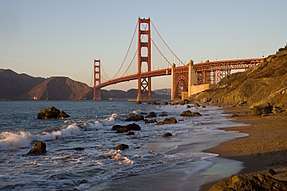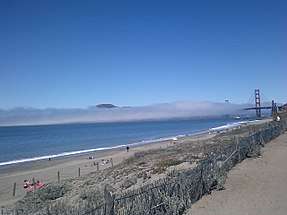Baker Beach
Coordinates: 37°47.592′N 122°29.04′W / 37.793200°N 122.48400°W


Baker Beach is a public beach on the peninsula of San Francisco, California, U.S.. The beach lies on the shore of the Pacific Ocean in the northwest of the city. It is roughly a half mile (800 m) long, beginning just south of Golden Gate Point (where the Golden Gate Bridge connects with the peninsula), extending southward toward the Seacliff peninsula, the Palace of the Legion of Honor and the Sutro Baths. The northern section of Baker Beach is "frequented by clothing-optional sunbathers,"[1] and as such it is considered a nude beach.[2][3]
The 160 acre property was settled by John Henry Baker in the 1850s and was known as Golden Gate Milk Ranch. The property location description varied, but is generally described as being approximately four miles west of the city on the then Point Lobos Road (now Geary Blvd.)
Baker died in 1863 and his widow, Maria, lost the property to foreclosure in 1879. In 1897, Baker's grandson, Fairfax Henry Wheelan sued [4] to have the title returned to the heirs of John H. Baker citing the claim that Baker's widow did not have the legal power to mortgage the property.
History
Baker Beach is part of the Presidio, which was a military base from the founding of San Francisco by the Spanish in 1812 until 1997. In 1904, it was fortified with disappearing gun installations known as Battery Chamberlin, which can still be viewed today.[5] When the Presidio was decommissioned as a U.S. Army base, it became part of the Golden Gate National Recreation Area, which is administered by the National Park Service.
From 1986 to 1990, the north end of Baker Beach was the original site of the Burning Man art festival. In 1990, park police allowed participants to raise the traditional large statue but not to set it on fire, since the beach enforces a limit on the size of any campfires. Subsequent Burning Man events have taken place in Black Rock Desert, Nevada.[6]
A fatal shark attack occurred on Baker Beach on May 7, 1959[7] when 18-year-old Albert Kogler Jr. was attacked by a great white shark while he was in water 15 feet deep.[8] This was the only shark attack recorded on Baker Beach.
Large outcrops of serpentine cliffs occur along the Pacific coast near Baker Beach. When rising from the land surface, serpentine produces a low-calcium, high-magnesium soil that can allow for rare species of plants to develop in the vicinity.[2] This may explain the presence of Hesperolinon congestum (the Marin Dwarf Flax, a threatened plant) in surrounding areas.
See also
References
- ↑ Baker Beach, California – Northern CA’s Best Nude Beach
- 1 2 "Baker Beach" ParksConservancy.org. Retrieved 8 May 2009.
- ↑ "Baker Beach - Nude Beach Profile" About.com. Retrieved 8 May 2009.
- ↑ "San Francisco Call 20 October 1897 — California Digital Newspaper Collection". cdnc.ucr.edu. Retrieved 2018-05-23.
- ↑ "Battery Chamberlin 1904-1948". Presidio of San Francisco. National Park Service. Archived from the original on 1 September 2009. Retrieved 2009-09-05.
- ↑ "The Early Years: Baker Beach" BurningMan.com. Retrieved 8 May 2009.
- ↑ "Annotated List of Authenticated Fatal Shark Attacks Along the Pacific Coast of North America 1900 - Present" Archived 2013-10-21 at the Wayback Machine. SharkResearchCommittee.com.
- ↑ "Fatal Shark Attacks" SoutheasternOutdoors.com.
External links
